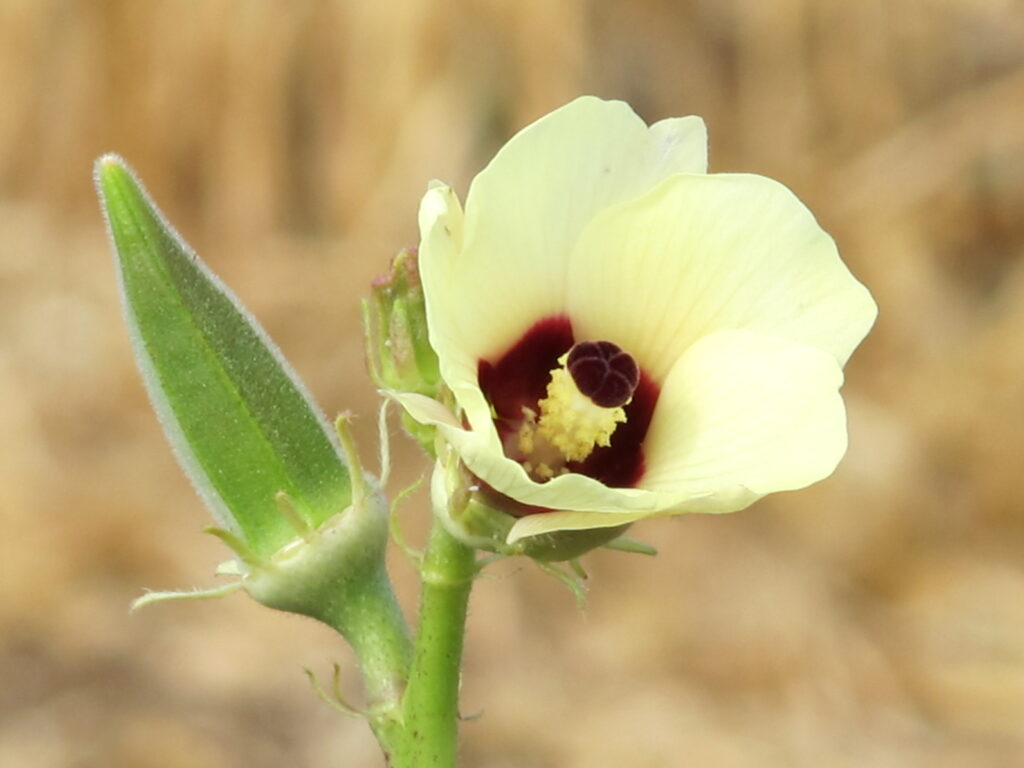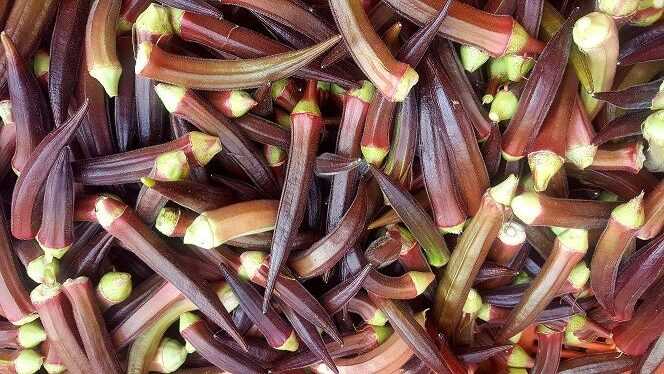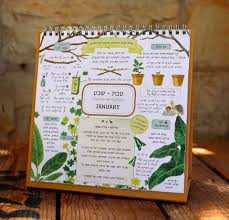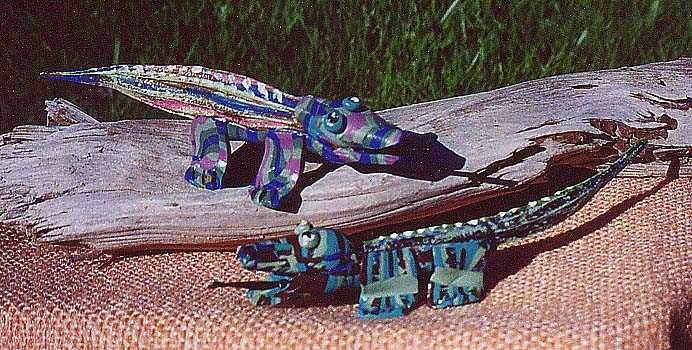
The Shana Bagina calendar and weekly journal created annually by Ilana Stein, artist and gatherer, walk you through the direct connection between seasons and local agriculture and gathering.
They serve as a unique, detailed guide to domestic Israeli gardening and nature, accompanied by beautiful illustrations, tips for home gardening and seasonal vegan recipes.
The focus of the newest (sixth!) edition, “Thinking Global, Eating Local,” is dedicated to our amazing local vegetation.
Now is the time to get acquainted with the nutritious local plants in our surroundings, and to enjoy their availability and nutritional value.
A Year in the Garden products include a hanging/tabletop calendar, a weekly journal, and magnets with seeding schedules. Take a peek at the beautiful charm of Ilana’s calendar right here
Prices: Hanging/tabletop calendar: 75 NIS Weekly journal – 85 NIS Pair of magnets: 27 NIS (prices reduced for purchases in quantity)
A beautiful and distinctive gift for your loved ones (yourselves included…). Add these stunning calendars to your order via our order system.
_________________________________
Okra – No Joke(ra)!
The day okra appears in your boxes, you know that summer has arrived in full force. Because okra is a summer tale of a plant born in Africa, which migrated north to the Arabian lands and the Middle East before eventually reaching the American Deep South aboard slave ships. In every locale, it flourished in the great heat.
This is also a tale of family warmth – of memories from our mothers’ and grandmothers’ (and lately our fathers’ and grandfathers’) kitchen, of delicious dishes whose magic is so much greater than the actual ingredients. Here too, warmth is a central component.
In my family as well, okra is a family tale. My father, a full-fledged Yekke (Jew of German origin) is an avid fan of okra and he passed his legacy on to us. I, in turn, introduced the love of okra to my daughters, to the point where the one who discovers the first okra delivery of the season immediately announces with glee: “Okra’s here! Let the season begin!” When they were younger, they loved cutting off the pod and discovering the little “stars” that appear when slicing the okra horizontally. As they grew, they began to concentrate on the flavor as well, and even an extra large skillet with okra stir-fried in lemon and garlic does not last long in our home.
Okra likes to prance around using her fancy name “Lady Fingers,” indicating that she must be treated with gentle respect. Before cooking, the tip must be gently cut off, taking care not to hurt the pod. In olden times, when a groom’s family wanted to “check out” a bride, they handed her a knife, a pile of okra, and put her to work. If she was able to properly slice it, this was a sign she was gentle and skilled.
But to the harvesters, okra does not put on her dainty lady show. Okra bush contain etheric oil, and any brush against them causes a terrible itch, which is why okra is harvested wearing long sleeves and gloves. This crop is harvested in large quantities, and we visit the okra beds every other day so as to avoid finding ourselves facing a lady who missed her date with the manicurist and let her nails grow out of control… Harvesting takes a really long time, as the pods must be searched for among the tangled brush of foliage and then picked one by one. Very personal treatment.
But although she is royalty, okra is also one of the only crops which does not force us to kneel down before it. The bushes quickly grow taller, reaching an impressive height of 3 meters! At that point, it is already high above us and we must bend its flexible branches in order to reach its pods. Another thing that makes us happy when we harvest okra is the beauty of its flowers. Okra belongs to the Malvaceae family (along with chubeza, cotton, hibiscus and hollyhock). Not many members of the family are edible, but they are all rather beautiful. Our okra boasts large, lush yellowish flowers, with a vivid purple center.

Okra began its domesticated path in the world over 1,000 years ago in tropical Africa, in the Ethiopia-Eritrea-Sudan area, where it can still be found growing wild today. From there it crossed the Red Sea to Saudi Arabia and took off to North Africa, the Middle East and India. It is unclear how this journey occurred, and there are very mysterious periods within okra history, but it did become a unanimously-loved food in all those countries. Okra arrived in Europe, compliments of the Muslim Moors, in the 12th century. It made its debut in the new American continent via two sources: African slaves hauled to the colonies carried okra to Brazil and South America, while simultaneously French settlers, who knew it from Europe, brought okra to Louisiana. Over the past decades, okra became a vaunted vegetable in the Asian kitchen, specifically the Japanese. So one does not have to be Egyptian or Greek to hold this vegetable in esteem.
The local okra variety indigenous to Israel has small – even tiny – pods. Traditional wisdom is to steer clear of a pod larger than your pinky, as this is a sign of an okra which is over-mature and too fibrous. On the contrary, the green and red okra variety that Chubeza grows is the Thai okra: longer, bigger and a bit less slimy. Don’t be put off by the size – it’s simply a different cousin, but not any less amazing than other family members. If I dare say so myself, in many recipes it’s even better!

(Thank you, Dafna. for the beautiful picture)
But despite its beauty, some people are repulsed by the modest okra. The reason generally cited is its “texture,” or in other words: “that slimy stuff that oozes out when it’s cooked.” That’s a pity, because that “slimy stuff” holds the okra in its Cinderella state, still in rags, waiting to be discovered for all its charms. There are many ways to reduce the slime, which I will get to soon, but let us first discover the charms of Cinderella.
One of the most amazing things about okra is that it can be used in a great variety of ways, some of which aren’t fully utilized today. We usually cook, roast or fry the young pods (3-5 days old), which is, of course, great. They are rich in vitamins K, A and C, plus folic acid, calcium, magnesium and potassium. The dietary fibers aid in preventing constipation and in stabilizing blood sugar levels by slowing down the process of sugar absorption in the digestive system. Okra also absorbs cholesterol and removes stomach acids containing the toxins that did not pass through the liver’s filtering system. Its dietary fibers are unique in that they feed the good intestinal flora. As it matures, okra’s fibers grow more and more rigid (which anyone who ever tried to chew a mature pod can attest to) and hold an unfulfilled potential as raw material for the rope and paper industry.
Yet its assets are not only in the pod fibers, but also in its little seeds: the oil produced from them is quite healthy and unsaturated, with characteristics resembling the lauded olive oil. The tiny seeds contain vegetal protein, like soybeans, and they are rich in tryptophan and contain amino acids – a most important combination for vegetarians. Ground okra seeds were used in the past (and in some places, in the present) as caffeine-free substitutes for coffee, like the chicory root.
But if you still wish to reduce the slime level in cooking, there are several options:
– Leave the pod whole (cut off the stem, but do not open the pod)
– Prepare quickly and easily by stir-frying or frying, not by lengthy cooking in liquids.
– Combine with acidic foods: tomatoes, lemon juice or vinegar.
Another surprising and attractive use for okra is in arts and crafts. Okra pods make fanciful dragons, or can be cut horizontally to become delicate star-shaped stampers. Note the pictures:
This week is a week of holidays: our Thai workers celebrated Queen Day last Tuesday, and the Muslim’s Eid El Adha on Sunday and Monday. And today – Wednesday – we celebrate Tu B’av – a day of love and partnership. Happy holidays to all!
Wishing everyone a healthy, fresh and festive week,
Alon, Bat Ami, Dror, Orin, and the entire Chubeza team
_______________________________________________
WHAT’S IN THIS WEEK’S BOXES?
Monday: Cherry tomatoes/potatoes/bell peppers, lettuce, corn, watermelon/melon/Amaro pumpkin, cucumbers, tomatoes, New Zealand spinach/basil/Swiss chard, slice of pumpkin, parsley/coriander, eggplant, onions.
Large box, in addition: Zucchini, butternut squash, lubia yard-long beans/okra.
FRUIT BOXES: Grapes, pears, nectarines. Small box, in addition: Bananas. Large box, in addition: Mango
Wednesday: Cherry tomatoes, lettuce, corn, butternut squash/melon/Amaro pumpkin, cucumbers, tomatoes, New Zealand spinach/basil, slice of pumpkin, eggplant, onions. Small boxes: potatoes/lubia yard-long beans/okra.
Large box, in addition: Zucchini/bell peppers, parsley/coriander, lubia yard-long beans, potatoes
FRUIT BOXES: Grapes, banana, plums. Small box, in addition: Nectarines. Large box, in addition: Mango





